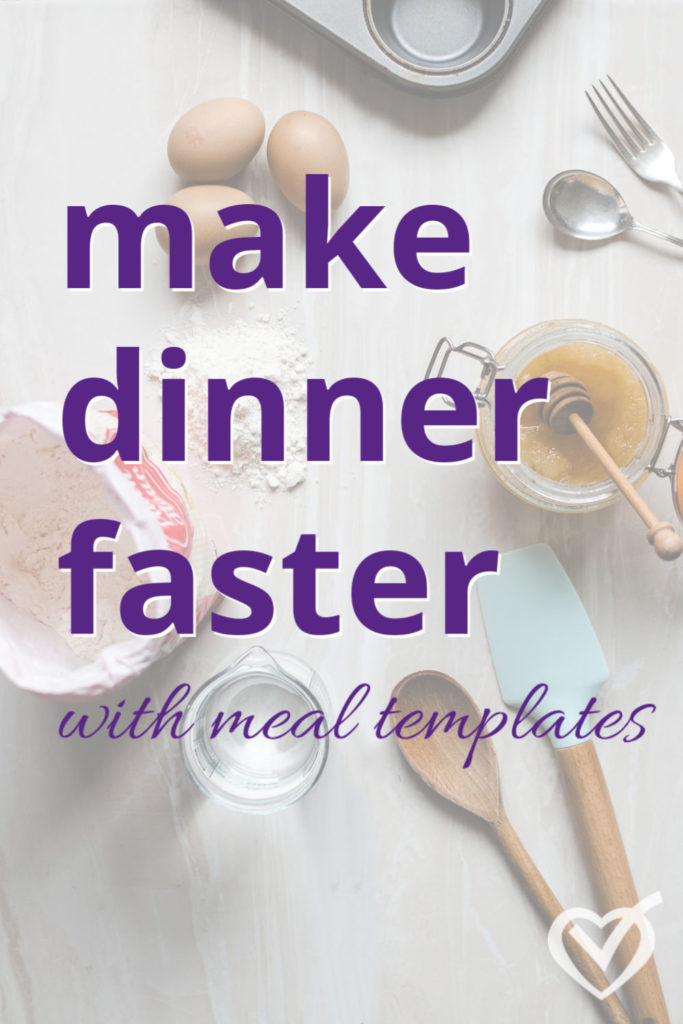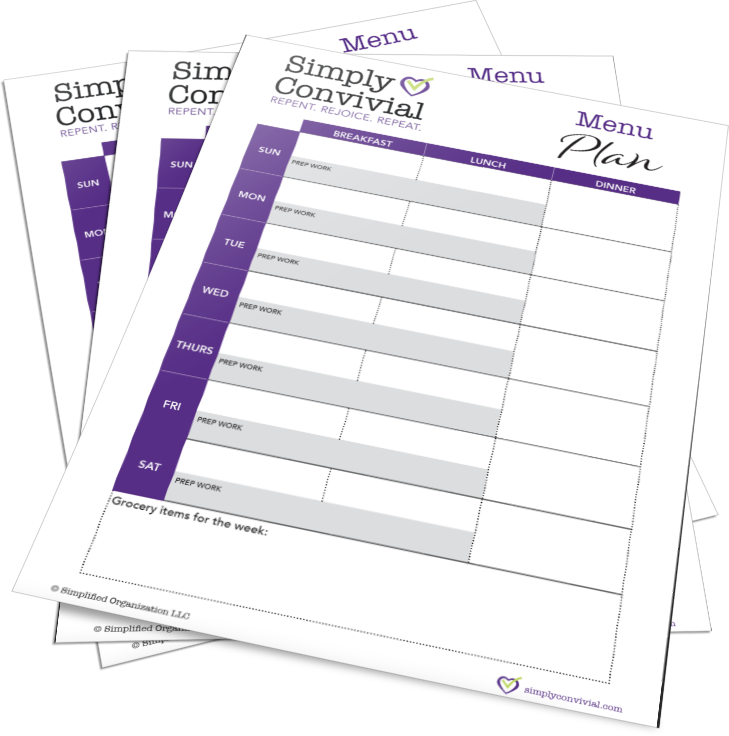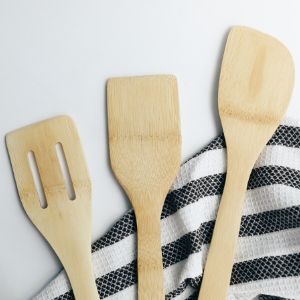Sometimes, it feels like getting dinner on the table is harder than it needs to be. Rightly or wrongly, we feel like we’re missing some secret or doing something wrong because we can’t make dinner faster – why does it take so much time to just get a meal on the table?
Finding both a dinner and weekly meal planning template will help you make dinner faster, every day, with less stress and no decision-fatigue.
Getting dinner on the table actually means coordinating a lot of moving pieces. That’s why there are services that will just give you the recipes and the shopping list and plot it out for you. It can feel like magic or some crazy skill that we just can’t figure out to get all of those pieces and parts to work together, but we don’t need those kind of done-for-you solutions when we simplify.
It’s really decision-fatigue that wears us down when it comes to dinner, and that’s why the subscription services are so popular. They simplify dinner by removing the decisions from the process.
We have to decide what we’re going to make for dinner, then look through the pantry and see what we have, and then decide what we have to buy, decide when to go to the grocery store, have that list, get the right things, then decide to do what’s on the plan in the evening — no wonder it wears us out.

Speed up dinner by simplifying
The whole meal process is involved and requires a lot of initiative and mental energy from us. Often we feel like that’s not where we want to spend our limited energy and attention.
The good news is that it doesn’t need to, least not long-term. We can spend some energy and attention and decision-making focus up front to set up some habits and systems. We can simplify the dinner-making process so it’s faster, so it doesn’t have to take all that out of us.
One of the ways that we can simplify dinner and make it easier is to actually remove options. Limiting our options is at the heart of simplifying and speeding up our cooking capacity because boundaries and limits actually help us to simplify and make things easier if we just accept them as the constraints we’re working with. Removing options removes decision-fatigue.
So, we work within the constraints of our situation and then we can even add further constraints if we need them. The more you need to simplify, the more decisions you need to eliminate; the more constraints and limitations you need to put in place.
Your own pantry holds the clues to simpler meals.
In Simplified Pantry, the process that we work through is taking an inventory of your actual pantry because you’ll find clues there and clues both as to what you do keep in stock, what you do use, what you need, and you make a list about what belongs in your pantry based on what is in your pantry, not just starting from scratch in some ideal world, but in your real life, what is in your pantry? What do you actually use and eat? Keep those things on hand.
On the other hand, what’s actually in your pantry also tells you what shouldn’t be in your pantry. When you find the stuff that’s been in there expired for two or three years, you know what you don’t use. We find our good ideas and our good intentions as pantry clutter. If it’s in your pantry and not being used, it’s clutter.
So, in decluttering our pantry, we’re doing more than clearing the space—we need to use that information to also clear our grocery lists, clear our recipes, clear our expectations, and simplify by cutting down on the number of ingredients that we even keep on hand because we aren’t looking to be the most varied or the best cook or all of these kind of grandiose, idealistic, or perfectionistic plans that we tend to gravitate toward when we are just planning on the blank sheet of paper.
Our pantry planning starts with the reality (both the good and the bad) that we find in our own homes.

Download the free menu planning templates – including a master pantry list – that will help you get every meal on the table with less fuss.
Choose dinners you know will be family hits.
Then we also look at the reality of the dinners that we really eat, that our family really loves. List those out.
If you’re going to make all of those regularly, what would you need to have on hand? What are some similar things? If you have a month or two months worth of dinners, I can do the math real quick, let’s just say that it’s 30 dinners (and there are going to be some leftovers and some things like pizza every week) that’s another thing a dinner template to make dinner easier is both a daily template and then a weekly template.
So, you don’t need to come up with a brand-new dinner every single day of every week. What are the family favorites? What are the family routines or even rituals? And you plug those in. So, that might be Taco Tuesday. That might be Pizza on Friday. Those are clichés for a reason and one of the reasons is that makes putting dinner on the table easier. So, come up with what are those dinners that your family will love even if they’re repeated every week? And just repeat them every week.
Make dinner faster with weekly rotations.
A weekly dinner rotation is a great way to simplify the menu planning process and make dinner faster. Choose a preparation method or a meat type or a starch type, assign it to a day of the week, and then list out 5-8 variations for each.
- pasta: spaghetti, chicken alfredo, stroganoff, tuna mac & cheese
- potato hash with ground beef or sausage and whatever vegetables are on hand
- crockpot meals
- soups
- chicken thighs with various marinades, served with crusty bread or biscuits or rolls
- tortilla-based dinner options
You can list those all out and it’s pretty easy to come up with 60-70. And if you have that many on hand, you have a lot of potential for simplifying.
You have can get good and fast at cooking each meal type so that you don’t require recipes and instructions for how to do any of your short list dinners.
The more you practice the easier it becomes so the more you make the same dinner the less mental energy it takes to make that. And it’s really the mental energy that we are wanting to save and that will make the most difference in how we feel about dinner and our day. It’s really less about the time and more about the mental energy when we simplify and make things easier.
So, you can rotate those dinners around. How many soups can you come up with? And then you can set a template for the week that allows for flexibility and that allows your family to think you’re making different dinners all the time and really in your mind and in your planning, it’s really the same thing over and over. So, for instance, if you have pizza every Friday you don’t need to menu plan.
We have pizza and we can have pepperoni pizza or ham and pineapple, list out some variations, so it’s not like the exact same thing all the time, but it’s pretty easy to keep those ingredients on hand. I always need the shredded cheese and I need flour (little harder these days), but you can do something similar with like a taco Tuesday. Maybe just think of it as Mexican and it could be burritos, it could be a leftovers in a tortilla. It could be chicken. It could be ground beef.
Soup, when it’s winter, I like to have soup night where it’s really brothy soup, and then another one where it’s like more stew soup or cream soup because there’s so many soups and usually they don’t take that much work. You have them with bread. There’s a lot of variety but it’s kind of the same process. In the summer then that could be a salad; pasta salad with chicken or tuna is something we do because my husband doesn’t think that salad counts as dinner no matter whether it has meat in it or not, salad is a side dish not dinner. So, I just said, okay, we’ll find your grilling chicken then. So we swap it out for grilled chicken.
There are multiple things that you could serve that are putting the same kind of meal on the table. They take the same kind of work and the same kind of time, but when you’re eating them it feels like a different dinner.
Plan faster dinners by using meal templates.
You can also you make a template for the day or the meal.
A basic meal template is meat + vegetable + starch and you just have to fill in each thing. Our dinner last night was an all-in-one dish, but each of those boxes were checked: chicken, broccoli, and rice.
It doesn’t have to be a mystery or a conundrum about what makes a complete dinner or is this enough or is this okay or is this healthy, is this filling, is this whatever?
And there’s a lot of variation in there. All kinds of possibilities, but you need protein and you need a vegetable and then people need to be filled up. Some of us need more starch than others for sure, but kids pretty much need some starch. So that’s how we think about it.
And lunch is usually something like that also, even if the protein is just cheese but some kind of protein, some kind of starch, and usually that’s fruit instead of a vegetable. That just helps pull things together. Do I have three pieces? Do I have the three pieces? Yep, okay, we’re good.
So, dinner doesn’t have to take a lot of concentration if we simply put boundaries around our choices and use templates to make planning and preparing simpler and smoother – and therefore faster.



This is such great advice! I found that decision fatigue was really impacting my ability to plan out meals, and when I schedule my week, then my dinners accordingly, it makes everything flow so much more smoothly!
Thanks for the great examples!
Thanks so much – this is great advice! On another one of your videos talking about Evernote you showed an editable template for a weekly menu. Is that still available somewhere? Thanks!